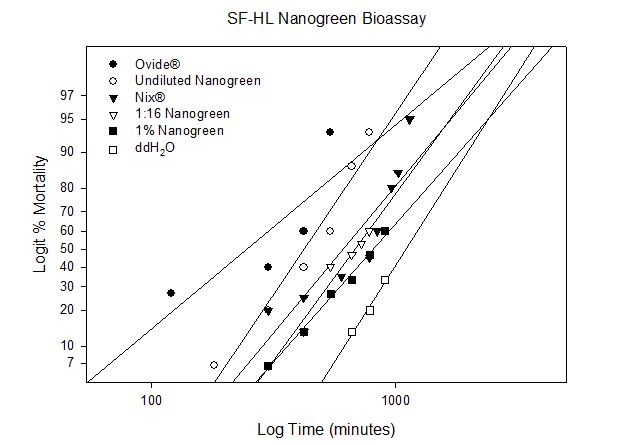Report/ Biobased Med (TM): Mortality Bioassay of Human Head Louse, Pediculus capitis, to Biobased Med (TM) Pediculicide Formulation.
Joseph Strycharz§, Kyong Sup Yoon§ and J. Marshall Clark§
§Department of Veterinary and Animal Science, University of Massachusetts, Amherst, Massachusetts 01003
Objective: Determine mortality of Biobased Med (TM) against permethrin-resistant head lice (SF-HL).
Materials and Methods
Louse Strains:Permethrin-resistant human head lice (SF-HL) were collected from infested children in Plantation and Homestead, FL and maintained on an artificial feeding system at the University of Massachusetts at Amherst, MA [1,2]. The SF-HL strain has previously been determined to be susceptible to Ovide® treatments [3].
Bioassays and Chemicals:Mortality bioassays were performed to determine lethal time 50 (LT50) values of the Biobased Med (TM) formulation compared to LT50 values of the formulated pediculicides (Nix® and Ovide®). Biobased Med (TM) dilutions were prepared from concentrate in distilled deionized water (ddH2O) at the instructed dilution of 1 part Biobased Med (TM) concentrate for every 16 parts ddH2O (1:16) and a 1% (v/v) Biobased Med (TM) dilution in ddH2O for comparison. Ovide® formulation containing 0.5% malathion, Nix® formulation containing 1% permethrin (v/v), and ddH2O were used as positive and negative controls, respectively, for comparison. All lice used in experiments were newly hatched first instars, randomly taken from the artificial feeding system and were fully satiated with blood meal prior to treatment.
Individual lice (15 lice/treatment) were gently handled using sterile forceps, submerged into a 1 ml aliquot of treatment for 5 sec then transferred to filter paper. After ten minutes, lice were individually washed by dipping them into three different water baths, each for 5 sec, containing ~10 ml of ddH2O. Washed lice were placed into labeled Petri dishes lined with filter paper and moved to an incubator (30 C, 75-85 % RH) for the remainder of the assay. For each treatment, the numbers of dead lice were counted under a dissecting microscope at hourly time intervals until 100% mortality was reached. A louse was considered dead if it could not right itself when inverted and legs had ceased all movement. Log time versus logit percent mortality regressions were generated to determine LT50 values and maximum log-likelihood ratio tests were performed to test the equality (slope and intercept) of the regression lines (Polo PC, LeOra Software, 1987)
Results
The mortality responses to all three of the Biobased Med (TM) treatments (undiluted, 1:16, and 1%) were significantly faster compared to the ddH2O treatment (χ2 = 54.7, df = 2, P <0.001; χ2 = 13.6, df = 2, P = 0.001, χ2 = 7.1, df = 2, P <0.029, respectively). The mortality responses to all three of the Biobased Med (TM) treatments were significantly slower compared to the Ovide® treatment (χ2 = 18.2, df = 2, P <0.001; χ2 = 36.1, df = 2, P <0.001; χ2 = 43.8, df = 2, P <0.001, respectively). The mortality response of the undiluted Biobased Med (TM) treatment was significantly faster compared to the Nix®, 1% Biobased Med (TM) and 1:16 Biobased Med (TM) treatments (χ2 = 17.6, df = 2, P <0.001, χ2 = 32.5, df = 2, P <0.001; χ2 = 17.8, df = 2, P = 0.001, respectively). The mortality responses of the 1:16 and 1% Biobased Med (TM) treatments were not statistically different than the Nix® treatment (χ2 = 0.5, df = 2, P = 0.779; χ2 = 4.8, df = 2, P = 0.091, respectively).
Discussion
The results determined that Biobased Med (TM) treatment had a significantly faster mortality
response than treatment with ddH2O, indicating that Biobased Med (TM) is pedicucidal on permethrin-resistant head lice. Additionally, undiluted Biobased Med (TM) treatment elicited faster mortality response compared to 1:16 and 1 % dilution of Biobased Med (TM) treatments, indicating that the undiluted Biobased Med (TM) is more potent than 1:16 and 1 % dilutions. Ovide® had the fastest mortality response of all treatments tested indicating that Ovide® is a faster acting pediculicide than any of the Biobased Med (TM) treatments using current formulations. Diluting Biobased Med (TM) according to the recommended 17 fold dilution did not work significantly faster than a 1% dilution, and both were statistically the same as Nix®. It has been proven that Nix® is not 100% effective at killing treated head lice using the hair tuft bioassay system [1]. Similar experiments need to be carried out for Biobased Med (TM) treatments. Also, further investigation is necessary to determine whether Biobased Med (TM) is ovicidal.
References
1. Yoon, K.S., Strycharz, J.P., Gao, J.-R., and Clark, J.M. (2005) Improved artificial rearing system for the human head louse allows the determination of resistance to formulated pediculicides. Pest Manag. Sci. (Submitted)
2. S.H.Lee, K.S. Yoon, M.S. Williamson, S.J. Goodson, M. Takano-Lee, J.D. Edman, A.L. Devonshire and J.M. Clark, Molecular analysis of kdr-like resistance in permethrin-resistant strains of head lice, Pediculus capitis, Pestic. Biochem. Physiol. 66 (2000) 130-143.
3. K.S. Yoon, J.-R. Gao, S.H. Lee, J.M. Clark, L.Brown and D. Taplin, Permethrin-resistant human head lice, Pediculus capitis, and their treatment, Arch. Dermatol. 139 (2003) 994-1000.

Figure 1.
Log time versus logit percent mortality responses of Biobased Med (TM)-, Nix®-, and Ovide®-treated human head lice from south Florida (SF-HL).
Table 1.
Median lethal time (LT50, min) values and slope from the south Florida (SF-HL) head lice population treated with Biobased Med (TM), Nix®, and Ovide®.
| Treatment | LT50 (CL)a | Slope | |
| 1% Biobased Med (TM) | 805.8b (675.7-1202.2) | 6.4 ± 1.9 | |
| 1:16 Biobased Med (TM) | 678.7b (586.2-871.0) | 7.5 ± 2.1 | |
| Undiluted Biobased Med (TM) | 437.3bc (370.6-499.6) | 9.3 ± 1.7 | |
| Nix® | 634.7 (467.1-769.6) | 7.4 ± 0.96 | |
| Ovide® | 236.1 (106.3-388.6) | 4.2 ± 0.86 |
a CL, 95% confidence interval limit.
b Logit regression is significantly slower compared to that of Ovide® treatment.
c Logit regression is significantly faster compared to that of Nix® treatment.